Intravenously Injected Pluripotent Stem Cell-derived Cells Form Fetomaternal Vasculature and Prevent Miscarriage in Mouse
- PMID: 33349053
- PMCID: PMC7873769
- DOI: 10.1177/0963689720970456
Intravenously Injected Pluripotent Stem Cell-derived Cells Form Fetomaternal Vasculature and Prevent Miscarriage in Mouse
Abstract
Miscarriage is the most common complication of pregnancy, and about 1% of pregnant women suffer a recurrence. Using a widely used mouse miscarriage model, we previously showed that intravenous injection of bone marrow (BM)-derived endothelial progenitor cells (EPCs) may prevent miscarriage. However, preparing enough BM-derived EPCs to treat a patient might be problematic. Here, we demonstrated the generation of mouse pluripotent stem cells (PSCs), propagation of sufficient PSC-derived cells with endothelial potential (PSC-EPs), and intravenous injection of the PSC-EPs into the mouse miscarriage model. We found that the injection prevented miscarriage. Three-dimensional reconstruction images of the decidua after tissue cleaning revealed robust fetomaternal neovascularization induced by the PSC-EP injection. Additionally, the injected PSC-EPs directly formed spiral arteries. These findings suggest that intravenous injection of PSC-EPs could become a promising remedy for recurrent miscarriage.
Keywords: cellular therapy; embryonic stem cells; endothelial progenitor cells; induced pluripotent stem cells; stem cell therapy.
Conflict of interest statement
Figures
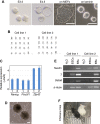
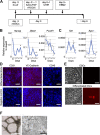
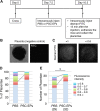
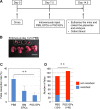

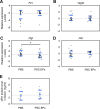
Similar articles
-
Bone Marrow-Derived Endothelial Progenitor Cells Reduce Recurrent Miscarriage in Gestation.Cell Transplant. 2016 Dec 13;25(12):2187-2197. doi: 10.3727/096368916X692753. Epub 2016 Aug 5. Cell Transplant. 2016. PMID: 27513361
-
Endothelial progenitor cells from human fetal aorta cure diabetic foot in a rat model.Metabolism. 2016 Dec;65(12):1755-1767. doi: 10.1016/j.metabol.2016.09.007. Epub 2016 Sep 28. Metabolism. 2016. PMID: 27832863
-
Identification of mouse colony-forming endothelial progenitor cells for postnatal neovascularization: a novel insight highlighted by new mouse colony-forming assay.Stem Cell Res Ther. 2013 Feb 28;4(1):20. doi: 10.1186/scrt168. Stem Cell Res Ther. 2013. PMID: 23448126 Free PMC article.
-
Endothelial Progenitor Cells as Molecular Targets in Vascular Senescence and Repair.Curr Stem Cell Res Ther. 2018;13(6):438-446. doi: 10.2174/1574888X13666180502100620. Curr Stem Cell Res Ther. 2018. PMID: 29732993 Review.
-
Directed differentiation of pluripotent stem cells to kidney cells.Semin Nephrol. 2014 Jul;34(4):445-61. doi: 10.1016/j.semnephrol.2014.06.011. Epub 2014 Jun 13. Semin Nephrol. 2014. PMID: 25217273 Free PMC article. Review.
Cited by
-
Clinical Application of Spiral CT Reconstruction Imaging in Patients with Tracheal Stenosis before Anesthesia.Contrast Media Mol Imaging. 2022 Aug 29;2022:9633527. doi: 10.1155/2022/9633527. eCollection 2022. Contrast Media Mol Imaging. 2022. Retraction in: Contrast Media Mol Imaging. 2023 Jul 12;2023:9879686. doi: 10.1155/2023/9879686. PMID: 36105451 Free PMC article. Retracted.
-
ALKBH5 modulation of ferroptosis in recurrent miscarriage: implications in cytotrophoblast dysfunction.PeerJ. 2024 Oct 18;12:e18227. doi: 10.7717/peerj.18227. eCollection 2024. PeerJ. 2024. PMID: 39434797 Free PMC article.
References
-
- Practice Committee of the American Society for Reproductive M. Evaluation and treatment of recurrent pregnancy loss: a committee opinion. Fertil Steril. 2012;98(5):1103–1111. - PubMed
-
- Shahine L, Lathi R. Recurrent pregnancy loss: evaluation and treatment. Obstet Gynecol Clin North Am. 2015;42(1):117–134. - PubMed
-
- Bobe P, Chaouat G, Stanislawski M, Kiger N. Immunogenetic studies of spontaneous abortion in mice. II. Antiabortive effects are independent of systemic regulatory mechanisms. Cell Immunol. 1986;98(2):477–485. - PubMed
-
- Clark DA, Chaouat G, Arck PC, Mittruecker HW, Levy GA. Cytokine-dependent abortion in CBA x DBA/2 mice is mediated by the procoagulant fgl2 prothrombinase [correction of prothombinase]. J Immunol. 1998;160(2):545–549. - PubMed
Publication types
MeSH terms
LinkOut - more resources
Full Text Sources

